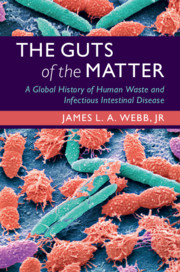Book contents
- The Guts of the Matter
- Studies in Environment and History
- The Guts of the Matter
- Copyright page
- Dedication
- Contents
- Figures
- Acknowledgments
- Introduction
- 1 Pathogens and Parasites
- 2 Early Change
- 3 Diffusion and Amplification
- 4 Innovations
- 5 Adoptions and Adaptations
- 6 The Struggle against Hookworm Disease
- 7 An Era of Optimism
- 8 Global Health and Infectious Intestinal Disease
- Conclusion
- Bibliography
- Index
5 - Adoptions and Adaptations
Published online by Cambridge University Press: 18 November 2019
- The Guts of the Matter
- Studies in Environment and History
- The Guts of the Matter
- Copyright page
- Dedication
- Contents
- Figures
- Acknowledgments
- Introduction
- 1 Pathogens and Parasites
- 2 Early Change
- 3 Diffusion and Amplification
- 4 Innovations
- 5 Adoptions and Adaptations
- 6 The Struggle against Hookworm Disease
- 7 An Era of Optimism
- 8 Global Health and Infectious Intestinal Disease
- Conclusion
- Bibliography
- Index
Summary
Chapter five, “Adoptions and Adaptations,” explores the evidence for the adoption of modern sewerage and water purification systems beyond the early centers in northern Europe and North America. The principal constraints to adoption of modern sanitation were fiscal, although ecological, political, and cultural forces also played large roles. The overall result was that the sanitation revolution beyond the North Atlantic was adopted piecemeal and that the benefits were generally concentrated in the core urban areas inhabited by those with political and economic power. Into the mid-twentieth century, the flush toilet and the disposal of human waste via water carriage made little impact on the overall problem of excreta disposal, and even the provision of piped water was generally limited to the cities and large towns in which Europeans, local elites of European ancestry, and/or non-European elites had an authoritative presence.
- Type
- Chapter
- Information
- The Guts of the MatterA Global History of Human Waste and Infectious Intestinal Disease, pp. 85 - 102Publisher: Cambridge University PressPrint publication year: 2019

